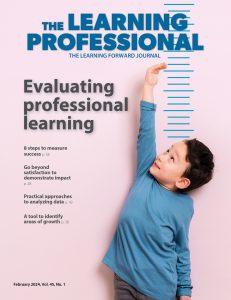Leading change can be like trying to pilot a ghost ship. How can a leader get the crew on board, guide the vessel and successfully navigate the turbulent waters of change? Understanding where educators are on the change continuum and personalizing their learning are important first steps for the success of any initiative.
Change is a challenge
Recently a principal shared the challenges of implementing a new program at her school. Teacher reaction to the initiative spanned the spectrum from enthusiasm, caution and complacency to fear.
Those who will be affected by the change are the most important factor in any change process. Teachers want to know how the initiative may impact their time, schedule, students, instructional practice, performance evaluation and way of work with colleagues. An effective leader must be sensitive to these concerns.
Fear of change can prevent teachers from moving forward. However, fear of the unknown is minimized over time with learning, practice and support from others.
What does the research say?
Fullan recommends that schools inquire deeper into their own practices, explore new ways to motivate their learners and discover the passion that makes teaching exciting. “The principal’s role is to lead the school’s teachers in a process of learning to improve their teaching, while learning alongside them about what works and what doesn’t” (Fullan, 2014).
Couros encourages creating a mindset in schools where innovation is the norm. He advises, “Compliance does not foster innovation. In fact, demanding conformity does quite the opposite” (Couros, 2015).
Hord identifies seven stages of concern in the change process in the Concerns Based Adoption Model. This research found that some educators will go through all the change stages. Educators may also experience several stages simultaneously (Hord, 2013).
Sails, surfers, anchors
A simple way to think about change is the educator’s response to the change. Three types of learners emerge when implementing a change, Sails, Surfers, and Anchors. A description of each level with strategies for personalizing their learning during the change process clarifies the differences.
Sails
“Sails” are enthusiastic initiative implementers. They willingly collaborate with colleagues to become learning leaders. Sails react to innovation as fair winds that billow their sails and lift their learning. Sails are social learners, shapers and risk-takers. They are interested in learning far beyond boundaries and team with others to shape, or chart a course of deep exploration. Sails focus on collective efficacy. They know how to adjust the sails to get to their destination.
Learning Strategies
- Unleash their talents.
- Support innovation and investigation.
- Endorse their collaboration.
- Allocate adequate resources.
- Confirm alignment of their explorations with the initiative.
- Encourage refinement of strategies and practices.
- Channel ideas and energies creatively.
- Expand their visibility.
- Provide opportunities for others to observe them.
- Scale their practice across other classrooms.
Surfer
“Surfers” are cautiously willing to learn more about the change. They ask questions about how the initiative will impact their instructional practice. Their focus is on the initiative expectations and guidelines. Surfers attend to the immediate demands of the initiative, not what it could be in the future. A “surfer” often prefers to learn independently. Their destination is wherever the wave, or initiative, takes them.
Learning Strategies
- Develop attainable initiative goals, expectations, guidelines, strategies, activities and timelines.
- Clarify the initiative steps and components frequently.
- Address “how-to” issues specifically.
- Encourage and support the initiative while maintaining expectations.
- Demonstrate how the innovation can be implemented sequentially.
- Schedule observations in classrooms where the initiative is implemented effectively.
- Engage in the feedback process.
- Find opportunities to share their knowledge and skills.
- Brainstorm solutions collaboratively when issues arise.
- Reinforce results.
Anchors
“Anchors” can be tone deaf about new initiatives. They are anchored in their comfort zone and resist change. Content with the status quo, they are skeptical about new learning. Anchors are self-focused and seek safe harbors.
Learning Strategies
- Acknowledge that initiative skepticism is reasonable.
- Legitimize their personal and professional concerns.
- Over communicate, sharing clear and accurate information in many ways.
- Encourage discussion and engage in the feedback process often.
- Share how the innovation relates to their current instructional practice, both the similarities and the differences.
- Connect them with enthusiastic implementers.
- Include them in initiative decisions.
- Reinforce their professional capabilities.
Sail, Surfer or Anchor. Which are you? Educators may be a combination of each of these styles, depending on the situation. The art of leadership is in understanding the difference and guiding teachers to use their talents productively to promote student learning. This is where the learning lies for change leaders.
Tips for leading the change process
The strategies for working with Sails, Surfers and Anchors are intended for individual educators. Change leaders, like my principal colleague, can benefit from these tips to manage change from the broader school or system perspective.
- Develop a shared vision of success for the initiative.
- Create a caring and trusting learning culture.
- Build relationships.
- View the change from the educator perspective.
- Acknowledge that change is a challenge.
- Be responsive to individual reactions to change.
- Listen to educator voices and observe their practice.
- Set clear goals.
- Learn alongside educators.
- Communicate continually.
- Include stakeholders in decisions.
- Monitor program implementation and assess progress.
- Engage with educators in the feedback process.
- Keep connected with the learning community.
- Measure results.
- Celebrate success.
Navigating change successfully
Implementing new initiatives can be like navigating through uncharted waters. By framing new programs in terms of change levels and applying personalized learning strategies, leaders have a compass to guide their work. School leaders, like my principal colleague, can enhance learning and position the school to thrive in an atmosphere of change. Having a sense of place, passion and partnership also helps.
When challenged with a new initiative, find fair winds, following seas and supportive mates. Take the helm. Calm your fears. Stay the course. Success is just ahead on the horizon.
For reflection…
Q. Why is understanding levels of change important?
Q. Who are the Sails, Surfers and Anchors in your setting?
Q. How can you work with Sails, Surfers and Anchors to affect the change you want?
Q. What strategies for implementing change have been successful for you?
Q. How have these ideas about change caused you to think differently?
References
Couros, G. (2015) The innovators mindset: Empower learning, unleash talent and lead a culture of creativity. San Diego, CA. Dave Burgess Consulting, Inc.
Fullan, M. (2014). The Principal: Three Keys to Maximizing Impact. San Francisco, CA. Jossey-Bass.
Hord, S. (2013). Implementing Change through Learning: Concerns-Based Concepts, Tools, and Strategies for Guiding Change. Thousand Oaks, CA. Sage Publications.






